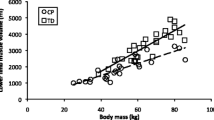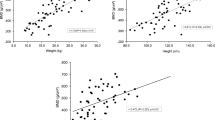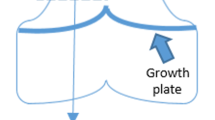Abstract
Summary
This work explores the relationships of muscle strength and areal bone mineral density (aBMD) in ambulatory children with cerebral palsy (CP). The knee extensor strength, but not motor function, was related to aBMD. Thus, muscle strength, especially antigravity muscle strength, was more associated with aBMD in these children than motor function.
Introduction
Muscle strength is related to bone density in normal children. However, no studies have examined these relationships in ambulatory children with CP. This work explores the relationships of muscle strength and aBMD in ambulatory children with CP.
Methods
Forty-eight ambulatory children with spastic CP, aged 5–15 years, were classified into two groups based on Gross Motor Function Classification System levels: I (n = 28) and II (n = 20). Another 31 normal development (ND) children were recruited as the comparison group for the aBMD. Children with CP underwent assessments of growth, lumbar and distal femur aBMD, Gross Motor Function Measure-66 (GMFM-66), and muscle strength of knee extensor and flexor by isokinetic dynamometer.
Results
The distal femur aBMD, but not lumbar aBMD, was lower in children with CP than in ND children (p < 0.05). Children with level I had greater knee flexor strength and GMFM-66 scores than those with level II (p < 0.001). However, the knee extensor strength and distal femur and lumbar aBMD did not differ between two groups. Regression analysis revealed the weight and knee extensor strength, but not GMFM-66 scores, were related positively to the distal femur and lumbar aBMD (adjusted r 2 = 0.56–0.65, p < 0.001).
Conclusions
These results suggest the muscle strength, especially antigravity muscle strength, were more associated with the bone density of ambulatory children with CP than motor function. The data may allow clinicians for early identifying the ambulatory CP children of potential low bone density.
Similar content being viewed by others
References
Ward KA, Caulton JM, Adams JE, Mughal MZ (2006) Perspective: cerebral palsy as a model of bone development in the absence of postnatal mechanical factors. J Musculoskelet Neuronal Interact 6:154–159
Schoenau E, Fricke O (2008) Mechanical influences on bone development in children. Eur J Endocrinol 159(Suppl 1):S27–S31
Binkley TL, Specker BL (2008) Muscle–bone relationships in the lower leg of healthy pre-pubertal females and males. J Musculoskelet Neuronal Interact 8:239–243
Chan DC, Lee WT, Lo DH, Leung JC, Kwok AW, Leung PC (2008) Relationship between grip strength and bone mineral density in healthy Hong Kong adolescents. Osteoporos Int 19:1485–1495
Schonau E (1998) The development of the skeletal system in children and the influence of muscular strength. Horm Res 49:27–31
Daly RM, Stenevi-Lundgren S, Linden C, Karlsson MK (2008) Muscle determinants of bone mass, geometry and strength in prepubertal girls. Med Sci Sports Exerc 40:1135–1141
Fonseca RM, de Franca NM, Van Praagh E (2008) Relationship between indicators of fitness and bone density in adolescent Brazilian children. Pediatr Exerc Sci 20:40–49
Rosenbaum P, Paneth N, Leviton A, Goldstein M, Bax M, Damiano D, Dan B, Jacobsson B (2007) A report: the definition and classification of cerebral palsy April 2006. Dev Med Child Neurol Suppl 109:8–14
Henderson RC (1997) Bone density and other possible predictors of fracture risk in children and adolescents with spastic quadriplegia. Dev Med Child Neurol 39:224–227
Henderson RC, Kairalla J, Abbas A, Stevenson RD (2004) Predicting low bone density in children and young adults with quadriplegic cerebral palsy. Dev Med Child Neurol 46:416–419
Henderson RC, Kairalla JA, Barrington JW, Abbas A, Stevenson RD (2005) Longitudinal changes in bone density in children and adolescents with moderate to severe cerebral palsy. J Pediatr 146:769–775
Henderson RC, Lark RK, Gurka MJ, Worley G, Fung EB, Conaway M, Stallings VA, Stevenson RD (2002) Bone density and metabolism in children and adolescents with moderate to severe cerebral palsy. Pediatrics 110:e5
Henderson RC, Lin PP, Greene WB (1995) Bone-mineral density in children and adolescents who have spastic cerebral palsy. J Bone Joint Surg Am 77:1671–1681
Jekovec-Vrhovsek M, Kocijancic A, Prezelj J (2005) Quantitative ultrasound of the calcaneus in children and young adults with severe cerebral palsy. Dev Med Child Neurol 47:696–698
Chen CL, Ke JY, Wang CJ, Wu KPH, Wu CY, Wong MK (2011) Factors associated with bone density in different skeletal regions in children with cerebral palsy of various motor severities. Dev Med Child Neurol 53:131–136
Chen CL, Ke JY, Lin KC, Wang CJ, Wu CY, Liu WY (2011) Anthropometric and fitness variables associated with bone mineral density and broadband ultrasound attenuation in ambulatory children with cerebral palsy. J Child Neurol. doi:10.1177/0883073810385235
Wilmshurst S, Ward K, Adams JE, Langton CM, Mughal MZ (1996) Mobility status and bone density in cerebral palsy. Arch Dis Child 75:164–165
Palisano R, Rosenbaum P, Walter S, Russell D, Wood E, Galuppi B (1997) Development and reliability of a system to classify gross motor function in children with cerebral palsy. Dev Med Child Neurol 39:214–223
Fung EB, Samson-Fang L, Stallings VA, Conaway M, Liptak G, Henderson RC, Worley G, O'Donnell M, Calvert R, Rosenbaum P, Chumlea W, Stevenson RD (2002) Feeding dysfunction is associated with poor growth and health status in children with cerebral palsy. J Am Diet Assoc 102:361–373
Impellizzeri FM, Bizzini M, Rampinini E, Cereda F, Maffiuletti NA (2008) Reliability of isokinetic strength imbalance ratios measured using the Cybex NORM dynamometer. Clin Physiol Funct Imaging 28:113–119
Russell DJ, Rosenbaum PL, Avery L, Lane M (2002) Gross Motor Function Measure (GMFM-66 and GMFM-88): user’s manual. MacKeith Press, London, United Kingdom
Harcke HT, Taylor A, Bachrach S, Miller F, Henderson RC (1998) Lateral femoral scan: an alternative method for assessing bone mineral density in children with cerebral palsy. Pediatr Radiol 28:241–246
Frost HM (1987) Bone "mass" and the "mechanostat": a proposal. Anat Rec 219:1–9
Frost HM (1997) Defining osteopenias and osteoporoses: another view (with insights from a new paradigm). Bone 20:385–391
Schoenau E (2005) From mechanostat theory to development of the "Functional muscle-bone-unit". J Musculoskelet Neuronal Interact 5:232–238
Fuchs RK, Bauer JJ, Snow CM (2001) Jumping improves hip and lumbar spine bone mass in prepubescent children: a randomized controlled trial. J Bone Miner Res 16:148–156
Acknowledgements
The authors would like to thank the National Science Council, Taiwan for financially supporting this research under contract nos. NSC 93-2314-B-182A-201 and 96-2314-B-182A-044-MY2. Ted Knoy is appreciated for his editorial assistance.
Conflicts of interest
None.
Author information
Authors and Affiliations
Corresponding author
Rights and permissions
About this article
Cite this article
Chen, CL., Lin, KC., Wu, CY. et al. Relationships of muscle strength and bone mineral density in ambulatory children with cerebral palsy. Osteoporos Int 23, 715–721 (2012). https://doi.org/10.1007/s00198-011-1581-6
Received:
Accepted:
Published:
Issue Date:
DOI: https://doi.org/10.1007/s00198-011-1581-6




